Hunting Fitness:
Preparing Your Body for the
Demands of Elk Hunting
Hunting fitness is often left off the preparations for the fall big game seasons. A hunter may be a crack shot with a well sighted in rifle or bow and have his hunting gear equipped with the latest gadgets and doo-dads by September or October, but if he’s not fit for hunting, it may all be for naught. Will you end up being camp cook with an injury?
This hunting fitness page is written for both the fit athlete hunter and the less intense hunters. There are some videos of drills below that will help you take it to the next level. The writer of this site and this page is a veteran competitive marathon runner/extreme athlete hunter who knows what it takes to be fit for the hunt!
Most of us know that we need to get away from the roads in order to increase the chances of killing an elk. The farther away from the roads we get, the more demanding the terrain and gravity become on our bodies, let alone moving that huge animal if we are successful.
Recent Articles
-
Bugling Bull Game Calls made by Rockie and Corie Jacobson
Bugling Bull Game Calls and Rocky Mountain Hunting Calls, by Rockie and Corie Jacobson, are available with free U.S. shipping over $50. The Jacobsons are the first family of elk calling! Steve Chapell…
Decrease Injury and
Heart Attack Risk
Unfit hunters also put themselves at greater risk for heart attack. High altitude means less oxygen is available, the basic need of all muscles, including the heart. The work required to hunt and move an animal is an unforgiving test of the heart muscle’s health status. Fitness training improves the efficiency of getting that oxygen where it is needed.
Under a doctor’s advice, increasing aerobic fitness through a hiking program will go a long way toward preventing a heart attack out in the woods where rescue treatment is going to be long on coming. Hunting fitness may well become a matter of life or death.
The earlier you can start getting fit for hunting, the easier it will be to simply enjoy being out there among the elk, even if you never take a shot. The fitter you are, the easier it will be.
The sights and sounds of elk country are breathtaking and serene, but it can take on an ugly hue in the eye of the unfit hunter whose body is aching and sore, limping along with a half-hearted dutiful determination.
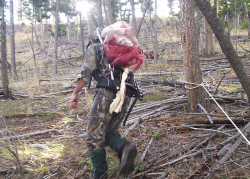
If you are successful at killing an elk, the task of packing the meat or entire carcass is very demanding on the body. Be prepared for the work of the harvest, not just the hunt.
(See our packing elk meat pages here.)
Overall Body Hunting Fitness
When establishing your hunting fitness plan, think about preparing your overall body strength, not just your legs. People don't realize it, but "balance strength" and "endurance strength" play a huge part in effective endurance events, which is what big game hunting is!
As we age into the 20s, 30s and beyond, growth hormone slows to a stop. We can keep that strength of youth, but we have to work at it more. Science has shown two ways remaining to add muscle mass after growth hormone runs out. 1. Eating protein at breakfast! 2. And, of course, working the muscles.
For many years, and I mean many since I started running long distance in 1971, I have been coached to add strength to my training regimen. Strength, especially core strength, also improves balance. Better balance wastes less energy. Good core and overall body strength improves efficiency of movement over long periods of time and rough terrain. The miles add up; for good or bad.
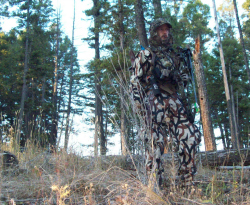
I admit to falling down many times through the years during most hunting seasons, but the more fit your body is, the easier it is to recover from or even avoid a slip with nothing worse than an off-color word and a scrape.
Carrying even a small amount of gear around all day can be done much easier with a body that has been strengthened by experiencing similar, preferably even harder physical stressors beforehand. A light backpack can take enough strength out of weak shoulders to make it difficult to hold a rifle steady or hold a drawn bow with good focus. Hunting fitness could mean the difference between success, a miss or even a wounded animal.
Start by Walking First
Start your hunting fitness routine early by putting one foot in front of the other, at the very least. Preferably with the same amount of weight you will carry while hunting. Start out with short distances and increase the time spent making tracks over several weeks or even months. If you can do your walking on terrain similar to what you will be hunting on, your training will be more specific to hunting fitness demands.
Walking for fitness will certainly prepare your heart, lungs and leg muscles to a large extent, but below are some hunting “strength specific” exercises you can add to that basic requirement which will greatly enhance your hunting fitness. These exercises will make traversing demanding terrain much easier for long periods and days, because balance and efficiency will improve along with aerobic improvement.
A hunter must not only prepare to walk farther than day to day life requires, she or he must prepare to walk on slanted surfaces for long periods. Elk don’t usually hang around in flat areas waiting for us to show up for a close encounter.
A hunter’s calves or thighs can soon begin screaming “Stop!”, if they haven’t been strengthened to handle the extended strain of going uphill or the harsh contraction of putting on the brakes on the way down. Or, hauling out meat on a backpack.
Even walking across a slant can put tremendous pressure on the leg muscles that aren't adapted to it. There are some specific hunting fitness strength exercises that will prepare for that, even without heading for the hills. There are some videos that show those exercises that we will add below.
Walking in deep snow causes us to raise our knees much higher than we’re used to. Prepare yourself in order to avoid being the hunter left in camp with an overuse injury. Don’t let failure to become fit for the hunt ruin your long awaited hunting outings.
Put together a series of exercises that you do every other day or so. Start with some stair stepping and bench step-ups.
Keep it Simple
There are free and quick ways of developing hunting fitness right in our own living room. It’s easy to come up with something stable about six to eight inches high to step up on while you’re watching a movie, the news or your favorite hunting channel on TV.
Stair Stepping
Alternate your legs up and down on your improvised stair stepper. How long? Don’t overdo it. Listen to your body. If it begins to feel like “too much, too soon”, stop and do some more later in the week. If you’re pretty fit to begin with, you might be able to start out at 10 minutes and build to fifteen minutes or more.
High Bench Step Up
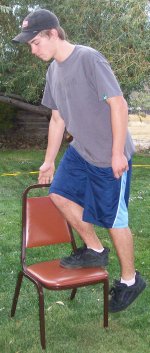
A high bench step up, because of added height, is a little more demanding than a simple stair step exercise, but is a very important exercise specific to good hunting fitness for the mountains and hills. Add this one after you have been doing some walking and stair steps for a couple of weeks.
For this you’ll simply need a stable bench or dining room type chair. The goal might be to do as many as three sets of ten on each leg, but start out with what you can handle without getting too sore and build up each week.
As you repeatedly step up with one leg, while you’re up there go ahead and raise the knee of your other leg until that thigh is parallel to the floor. With a little practice, you will develop better balance by using your arms as natural counter weights. You might use a wall for balance at first.
Complete an entire set (five to ten) on each leg before switching. Start with just a few of these. They can add up and cause soreness rather quickly. Build up slowly with anything you’re not used to doing.
Bicycle Leg Swings
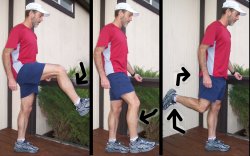
Add some bicycle leg swings. Put one hand on the wall or the back of a chair. Move your opposite leg forward, down and back around as if riding a bicycle, but in an exaggerated circle. This sounds and feels easy at first, but start out doing three sets of 30 or less on each leg and feel the burn!
Over several weeks, work up to as many as three sets of fifty on each leg in a minute or so for each set. You’ll be surprised at how much easier propelling yourself forward for long periods becomes after doing just these three exercises over the summer time. Add some ankle weights and feel the burn!
Bench Dips
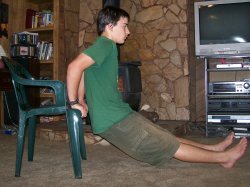
To add hunting fitness to your upper body for the demands of carrying a rifle and retrieving an animal start with some simple bench dips. Sit on the edge of a bench, chair or couch with your hands on the front edge next to your legs. Two chairs side by side facing you might work better.
Move your feet out away from you until your backside slides off the seat and your weight is on your heels and hands. Now raise yourself up and down in front of the couch with your arms. Again, start out with a few and work up to three sets of ten or more.
Ab Crunches
Lay on the floor with your hands on the side of your head. Squeeze your abdominal muscles and lift your head and shoulders off the ground a little without arching your neck.
These ab crunches don’t have to put “six packs” on your stomach to make you more fit for hunting. Build up to thirty to fifty of these. A stronger stomach will aid in protecting your back and will improve your balance. After they get easier, add some twists as you come up. Again, careful not to hurt something!
Back Extensions
Now turn over on your stomach and put your hands on your temples. Raise your shoulders and head off the floor just a little and you’ll begin immediately to strengthen the lower back. Strong abs and back muscles do a great deal to improve balance and efficiency of walking, stepping and climbing.

As always, just do a few at first to see how your body responds. Please! Start easy with this one! We use our backs more than we realize just to walk upright.
We’re reminded of that fact when our low back area gets tense after walking in elk or deer country all morning. As these become easier, you can carefully add some side twists as you come up.
Push-ups
If you’re not used to doing full-length push-ups, don’t feel like there is something wimpy about doing knee push-ups. Depending on your own body weight, even knee push ups can be pretty demanding.
Do some of these, building up gradually as always, to strengthen your chest, back and arms for the demands of moving yourself, your equipment and, hopefully, a heavy trophy animal across unforgiving territory.
Push ups with feet on the floor would be fine for someone who is not overweight, but be careful not to injure your shoulders by overdoing it. For advanced push ups, elevate your feet a little and keep your legs straight. Do some close-to-the-sides military pushups, wide stance pushups, and even diamond pushups (pointing fingers and thumbs together under your chest) to increase the difficulty.
Arm Presses
Consider adding simple press exercises to your hunting fitness routine, raising something with a little weight to it over your head repeatedly to strengthen your shoulders. When you raise your rifle, the aim will be steadier because of the added strength.
Stretch Band for Archers
Instead of just shooting your bow, add the use of an inexpensive stretch band to mimic the same kind of pulling/pushing effort with repeated sets. Your draw will be easier and smoother if you do these often each week.
Squat Thrusts
For overall body strength for hunting fitness, add some “squat thrusts” with hops (burpees) to the routine.
Squat to the floor and put your hands on the floor. Thrust your legs behind you. Do a push up. (The push up can be omitted.) With your hands still on the floor, contract your legs back up under you quickly. Then immediately jump up into the air a little. That’s one squat thrust. Start with ten and work up to thirty or forty.
I have done all of the above and more to train for competitive marathon racing and hunting through the years. They are simple, basic exercises that can be done a few times a week with little investment of time and no formal exercise equipment.
Add these to regular walking sessions and you’ll be amazed at how much easier the experience of stomping up and down hills, even in knee-deep snow, can be once you raise your overall hunting fitness level a little.
Be sure to read our page about staying hydrated and nourished during the hunt.
Want to Take it to the Next Level?
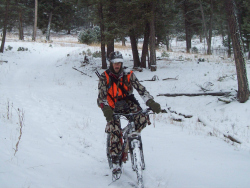
Here are some short videos of more intensive hunting fitness training drills and exercises that you can do, if your goals are more of an advanced athlete hunter. (We will be adding more.) Try to do these at least every other week or weekly for at least 4-5 weeks prior to the start of the season.
I often ride a mountain bike in the dark up a gradual climb until I reach my mountainous hunting area. The hunt starts after that early morning bike ride, with my legs already pulsing from the climb. That routine repeats itself about five days a week from early September through November to fill Montana elk and deer tags.
I want to be strong and fit enough to enjoy hunting for that entire period. I do these various strength exercises, along with distance running most of the year round, but back off come September. I got these from training manuals by Owen Anderson, PhD, a highly respected endurance exercise physiologist and coach.
Core and Upper Body Strength for Hunting
Our "core" is what holds us upright. Those sets of muscles also determine how efficiently we move around. We do a lot of moving around when we're hunting big game!
Core strength goes up dramatically when you do the exerices in this video. The stronger our core musculature is, the more efficiently our bodies move around and carry loads.
Do as many of all of these exercises as you can make time for. Start easy and build up. Getting injured will ruin your hunt! Build up and enable your body to move efficiently.
Here's a list of the exercises:
Floor to Shelf Twist
Feet Elevated Pushups
Planks
Rotating Drop Off and Pick Ups
Twisting Back Raises
Alternating Twisting Crunches
Bench Dips
Leg Strength for Hunting Fitness
The following hunting fitness exercises are mostly specific to leg strength. You won't find the usual leg reps being done with two legs at once in perfect balance. When hiking in big game country, we use one leg at a time. Weight is shifted from one leg to the other on slanted territory, for long periods of time.
These repetition exercises are designed to develop the endurance strength to maintain balance, so less energy is wasted. A few of these you will have never seen before. They will take some thought to put together after watching the video of each.
You'll be thinking, "this is weird", but they will help propel yourself in big game country! Start easy with them all. No need to hurt yourself. Build up gradually with all of the hunting fitness exercises.
These are just brief demonstrations of each one. You won't be need to workout along with them. No pretty girls in lycra, or studs with big gun muscles. Just little ole me, a small lifelong endurance runner that usually hunts alone and retrieves elk meat alone! (Sorry about the quality. I'm working on improving it, but wanted you to have it now.)
Hill Drills for Hunting Fitness
Some of these might look a bit silly, but wait until you feel the burn in your legs! You will be building small muscles in ways that you would not otherwise. They will serve as a stabilizers in the mountains and improve your efficiency while high-stepping over logs and rocks, as well as moving forward, climbing and level.
As stated at the end of the short video, it's a good idea to do something to get tired before doing these drills. Think about it. You won't be "fresh" several hours or days into your hunt. Or, when you have to haul out a big animal. So, get tired first. (Maybe some hard walking, or even running first.) Then, get even "tired-er" with these very specific-movement hill drills. They will build endurance strength for when you need it most- when you're tired and you have a long ways to go, or a load to haul out.
Please subscribe to or our Quick Elk Hunting Tips and Updatesnewsletter or to an RSS feed (see left column for both) to be alerted whenever new information is added to the site.
We'd appreciate it if you would "Like" us on Facebook, or share this site with others.
Search this site here:
Shop Our Store
Newsletter Opt-in:
"I just get so excited talking about elk.." ~Tristan, CO
Search This Site Here:
Hunting Gear Reviews
ASAT CamoElkNut Outdoor Prod.
Bugling Bull Game Calls
HECS Stealthscreen
Montana Decoy
StringSling Bow Sling
Skull Hookers
Safari Sling Rifle Sling
Clip-Shot Mini Camera Mount
ASAT Camo
Bugling Bull
Game Calls
ElkNut Productions
Free Shipping on
ElkNut Products Here
HECS Stealthscreen:
A New Type of Concealment!
$199.99,
Including U.S. Shipping
Montana Decoy Elk/Deer
Available Here!
The StringSling:
Best Bow Sling Design!
$29.95, Including U.S. Shipping
Clip-Shot: 1 oz. Camera Mount
Skull Hookers
$34.99 & 59.99 Free U.S. Shipping!
The Safari Sling:
Best Rifle Sling Design!
Share your elk hunting pictures and stories on our
Facebook Page!
Forum Topic Discussions:
How often should I use my cow call?, I am new to the sport of bow hunting elk and my question is how often should I use my cow calls?
295 yard kill with a Kimber Montana 325 WSM, by Don from Dallas: My ELk did not even twitch once. He was dead when he hit the ground.
325 WSM is worth considering, Palmer Lake,CO: I believe that the .325 WSM is the ultimate elk caliber...
30-30 for Elk? : I have a 30 30 with 170 grain round nose bullet. Will this work to shoot an elk ?
(More comments about Best Elk Rifle below)
Submissions
Unique Elk Talk by Idaho Steve (Hailey, Id ), In the middle of the night, a herd of elk came traveling through the drainage and right past my tent...
Smelly Elk Areas? by Jimmy (New Mexico), I've come across many areas that just stink of elk, literally. I have heard two somewhat contradictory stories...
DIY Gear List Must Have's! by Craig (Florida) "Here are some of the items I use on my DIY hunts in the CO backcountry..."
Elk and Deer Hunting and Mountain Bikes, by Skip Shepherd (Tucson, AZ)~ At 67 I am thinking a lot about investing in a mountain bike to get back into remote areas...
Solo archery hunting -- tips for calling/set up?, by Idaho Steve (Hailey, ID )~ I hunt by myself a lot...I'd love to hear your thoughts on strategic set-ups when solo hunting and calling.
Non- Lead Bullets for Elk?, by Dave, Elk Hunting Tips.Net (Garrison, MT)~ What do you ballistics guys think about the use of non-lead bullets for elk? According to this story...
Rage Broadheads by Chris, ...my buddy gave me a rage practice tip and when I shot it you could not pick out the broadhead from the field points. I was sold...
Recent Submissions:
Finally filled the freezer..., Colorado Rockies~ "I was bummed when I got to the property and no elk, nor any hoof prints in the snow. ...I pulled each of the elk into shade then started gutting..."
Wounded Veteran Elk hunts, by Joshua FL), I am a disabled veteran of Operation Iraqi Freedom and have always dreamed of hunting elk. I am posting this to see if anyone would know of any elk hunts free to disabled vets....
First Elk with a Bow, by Ryan H. (Colorado), ...Finally after many years of hunting with a bow "I got er did"!
First Elk!, by Tater (Sheridan, Arkansas) I took the advice I received from this website and was successful…I wanted to Thank You and Your Forum and the folks that share on here for the knowledge and information that helped me find an elk I was quite happy with.
Any success in Unit 14?, by: Dave (MI), "I'm planning on doing a DIY in Unit 14 for 2012..."
Bugle in Herd bulls, by Swiltbank (Az) The key to calling in a herd bull is to get into his bedding grounds and threaten his herd. Start off sounding like…
Best Rifle Caliber?, by Buglemup (Superior, MT), "I've been reading what people have been writing about rifle calibers and here is what 16 years of guiding elk has taught me."
7mm Remington Magnum, by Dean (Helena, MT. USA) I use my Liberty Ruger M77, 7mm Rem. Mag. for antelope, deer, elk... Comment: "What do you guys think about the idea of hunting elk with a 270? I also know a guy who kills elk with a 243."
338 Marlin Express, "Light, fast shooting, hard hitting, manageable recoil, and for a lever gun - very accurate."
Guns I like for Elk, by Mountain Walker (Kootenays east B.C. Canada),"I think the gun you shoot Elk with should be one you shoot a lot with... "
.35 Remington, by Bill Smith "...my .35 Rem appears to have dropped a medium deer flawlessly, but I now have serious doubts as to its capability to take an elk."
Where to hunt in Az unit 3B?, by Cliffjumper (Tucson, Az) ~ I got a late bull muzzle loader hunt in Arizona unit 3b. Does anyone know how to hunt bulls in the late season?...
First time elk hunter hunting Arizona unit 6A , by Rob Marchio (Omaha, Ne)~ I'm a first time elk hunter hunting Arizona's unit 6A. I'm planning on staying in the Pine Grove campground...
Help needed for 1st DIY Hunt w/Son, by Patrick (Parker, CO), "I was looking for some advice on my 1st DIY hunt for 2014 in CO with my 13 yr old son. I have countless hrs going over stats, topo maps & Google Earth"
Elk Hunting Colorado in 2013, By William (Midland, TX) "I am planning an elk hunt next year in Colorado and I wanted to know if hunting Gunnison National Forest..."
Unit 60 Elk 4th Rifle Season Nov 13-17 Either Sex 2013, By Chester "...Any general advice about the unit would be appreciated!"
Elk Hunting Idaho Unit 8 8A 11, This is my first year seriously trying to track down some elk. Is there anyone that has hunted in any of these units and can give me some friendly advice? Mitchell, Moscow Idaho
Elk Hunting Pocatello by Cameron (Pocatello) Where is the best place to elk hunt around Pocatello, Idaho? I'm a student at ISU and I'm looking for somewhere around here to hunt next season.
How is the elk hunting in unit 30A in Idaho?, by Terry (Richland Center, WI) Has anyone archery elk hunted in unit 30A in Idaho? What can you tell me about the area?
Hunting in Western Montana, by Mike A. (Alabama)
I did not draw a tag for Missouri breaks where I have hunted in the past. Having to start over and try western Montana.
New Mexico Unit 49, by Silas (Los Alamos, NM)
If anyone has tips on areas to start scouting, I'd really appreciate it.
First Elk Hunt First Elk Hunt, by Big "R" (NM)
I finally got drawn for a late elk hunt in Unit 28, north of Road 506 and south of the boundary line of the Lincoln National Forest...
Cow elk in Nevada's unit 222:
"Any good places known in unit 222?"
Northeast Nevada Early Elk hunt, by John (Carson City,NV)
"Any suggestions on what areas I may see some signs of elk?"
Retired USMC MSgt Needs Advice, by Ken Wing USMCRET (Bealeton, Va)
Popcorn VenisonPopcorn Venison with Maple Syrup?
Elk or Venison Steaks Grilled to Perfection Here's how to turn them into steakhouse steaks!
Spice-Crusted Grilled Venison Roast Recipe This Spice-Crusted, Grilled Venison Roast recipe works great for any red meat roasts, including elk, deer or beef roast...
Corned Elk Recipe You can easily make corned venison and elk, moose or corned beef from these instructions...
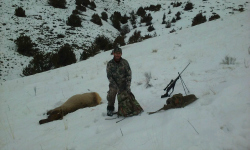
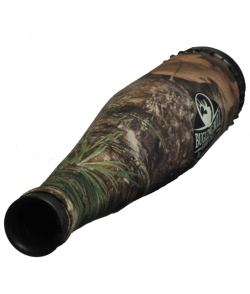
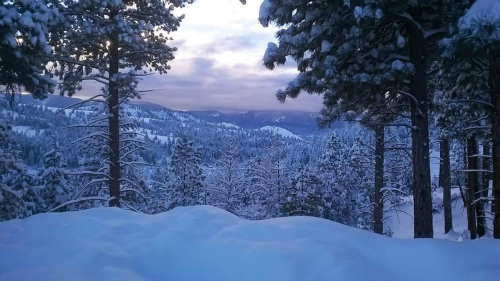






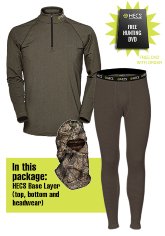
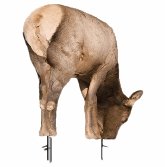
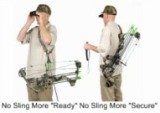
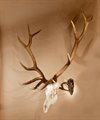
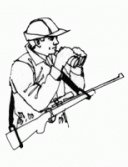
New! Comments
Leave a comment in the box below.